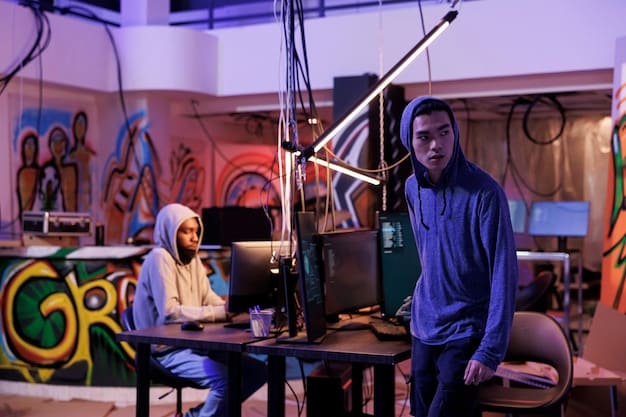Shonen Anime Voice Acting: US vs. Japan in 2025

In 2025, the US shonen anime voice acting industry continues to evolve, drawing inspiration from Japan’s established practices while adapting to local market demands, technological advancements, and a growing emphasis on diversity and representation.
The world of shonen anime voice acting is constantly changing, with the US and Japan taking different approaches. Let’s dive into the future of shonen anime voice acting: How does the US dubbing industry compare to Japan in 2025?
The Evolution of Shonen Anime Voice Acting
Shonen anime, with its action-packed storylines and dynamic characters, holds a special place in the hearts of fans worldwide. The voice acting, essential to bringing these stories to life, has undergone a significant transformation in both the US and Japan. How do these industries compare as we approach 2025?
The demands and expectations from voice actors are evolving. The comparison reveals nuances in training, technology adoption, and the overall creative process.
Historical Context
The journey of anime voice acting in the US began with a need to cater to local audiences. This involved adapting not just the language but also the cultural nuances. In contrast, Japan’s industry has deep roots dating back to the early days of anime production which shaped its standardized practices.
Technological Advancements
The introduction of digital recording and editing tools has had profound effects. The improvement in quality and flexibility has enabled more efficient workflows while raising new standards for audio fidelity. These technological shifts affect how voice actors perform and how studios produce their content.
- Increased demand for remote recording capabilities.
- Adoption of advanced noise cancellation and audio processing software.
- Growing use of AI-assisted tools for lip-syncing and dialogue editing.
The US and Japan have been adapting their strategies to suit changing customer expectations. The differences in their approaches reflect distinct cultural values, affecting the industry at large.

Training and Development of Voice Actors
A voice actor’s journey begins with rigorous training and continuous development. Both the US and Japan have distinct approaches, which create diverse outcomes for aspiring voice actors.
The cultural and industry differences provide different challenges and opportunities, so voice actors must adapt as globalization brings new perspectives.
Educational Pathways
In Japan, many voice actors emerge from specialized training schools that focus on vocal performance, character interpretation, and industry etiquette. These schools often have close ties with animation studios. In the US, aspiring voice actors often come from theatre, film, and other performance arts, relying on broader acting skills.
Mentorship and Apprenticeship
Japan’s industry emphasizes mentorship, with experienced voice actors guiding newcomers. This helps to pass down traditional techniques and industry know-how. The US has increased opportunities for workshops and online courses, democratizing access to training, but formal mentorship depends on individual connections.
- Emphasis on formal training in Japan vs. diverse backgrounds in the US.
- Role of mentorship in shaping the careers of Japanese voice actors.
- The rise of online coaching and workshops in the US.
Training also includes overcoming challenges. Voice actors in both countries aim to refine their skills, setting them apart from others. The diverse strategies are essential as competition increases.
Cultural Nuances in Voice Acting
Voice acting for shonen anime is influenced profoundly by cultural nuances. The way characters are portrayed, the type of language used, and the expressive style are all shaped by the values and expectations of the intended audience.
Understanding the ways culture influences voice acting reveals a deeper connection to the audience, which helps voice actors become more versatile.
Character Representation
In Japan, voice acting often involves a more stylized and exaggerated performance to match the visual aesthetics of anime. This theatrical approach is deeply tied to traditional Japanese performance arts. US voice acting tends to lean towards naturalism, aiming to create relatable and believable characters with authentic emotional depth.
Language Adaptation
Adapting the original Japanese dialogue for an American audience involves more than just direct translation. It requires cultural localization, ensuring that humor, slang, and references resonate with the viewers while preserving the original intent. This often calls for significant creative liberties.

- Differences in emotional expression between Japanese and US voice acting.
- Strategies for adapting Japanese humor and slang for American audiences.
- The role of cultural consultants in ensuring accurate and respectful portrayals.
These elements of voice acting can also make or break a show. Cultural sensitivity is a core skill. Versatility is also critical if talent want to thrive in this industry.
The Impact of Technology on Voice Acting
Technology is revolutionizing the voice acting industry, with new tools and techniques transforming how voice actors work and collaborate. These advances offer new levels of versatility while providing creative opportunities.
The impact of virtual collaborations, remote recording, and improved audio quality have reshaped the way voice actors engage in shonen anime dubbing.
Remote Recording
Remote recording has become essential in the voice acting landscape. High-quality microphones, soundproofing, and reliable internet connections allow voice actors to work from anywhere. This flexibility has broadened access to opportunities in the US.
Voice Enhancement Software
Advanced audio editing software helps refine voice performances, correcting imperfections and adding dynamic effects. Tools powered by AI can manipulate voices to create unique character sounds, enhance emotional delivery, and synchronize dialogue with animation more precisely.
Remote Work and Collaboration
The ability to collaborate remotely is changing the dynamics of voice acting. From script readings to recording, and feedback sessions, voice actors can work together regardless of their physical locations. This capability helps to create seamless, collaborative workflows.
- The increasing reliance on remote recording setups.
- How AI-powered tools are transforming voice manipulation and synchronization.
- New opportunities and challenges for voice actors in a remote-first industry.
The ability to capitalize on technology is essential. Understanding its capabilities gives voice actors the ability to do more, and it helps them stay ahead of the competition.
Diversity and Representation
Diversity and representation are increasingly critical in voice acting. Creating authentic and relatable characters means casting voice actors who mirror the diversity of the audience.
There are considerations for the social and ethical responsibilities of representing characters with authenticity.
Inclusive Casting
Casting calls that prioritize diverse backgrounds and experiences help to reflect the global audience of shonen anime. The casting ensures characters are portrayed authentically and respectfully, avoiding stereotypes.
Authentic Storytelling
When the diversity of voice actors matches the cultural backgrounds of characters, storytelling becomes more authentic. This approach enhances the emotional depth and resonance of the narrative, building a stronger connection with viewers.
- The ethical and social responsibilities of representing diverse characters.
- How diverse casting can drive more inclusive and authentic storytelling.
- Challenges and opportunities in promoting diversity in voice acting.
Representation matters because voice acting aims to connect with a wider audience. An inclusive representation can appeal to many who can imagine themselves in the world of shonen anime.
Future Trends in Voice Acting
Looking forward to 2025, several trends are poised to shape the future of voice acting. These trends reflect changing technology, audience expectations, and industry practices.
These developments affect the way voice actors will need to perform, and how studios will produce anime content.
AI Voice Synthesis
AI voice synthesis, while still in its early stages, is expected to advance to the point where AI can generate realistic and expressive voices. This technology can potentially assist voice actors by filling in for minor roles and providing dynamic voice options for animated characters.
Virtual Performances
Virtual performances are expected to become more common. Voice actors may perform live through virtual avatars, creating immersive fan experiences. Motion capture technology can enable voice actors to animate complete virtual characters in real-time, blurring the line between voice acting and performance art.
- Potential roles for AI-generated voices in anime production.
- The rise of virtual avatars and live virtual performances.
- How these trends will change the skills and requirements for voice actors.
Adaptability to these trends offers more opportunities for voice actors. Embracing these technologies can open new creative avenues and extend the impact of voice acting.
| Key Point | Brief Description |
|---|---|
| 🎤 Training | Japan: Specialized training schools. US: Diverse performance arts backgrounds. |
| 🗣️ Cultural Nuances | Japan: Theatrical. US: Naturalistic. Language adaptation requires localization. |
| 🌐 Technology | Remote recording, voice enhancement software, AI transforming performance. |
| 🎭 Diversity | Inclusive casting, authentic storytelling enhance resonance with viewers. |
FAQ
▼
Japanese voice actors typically undergo formal training in specialized schools, emphasizing vocal performance and industry etiquette. US voice actors often come from diverse performance backgrounds, with broader acting skills.
▼
Adapting the dialogue from Japanese involves more than translation; it includes localization. Ensuring humor, slang, and cultural references resonate with American viewers, while remaining faithful to the original story is key.
▼
Remote recording has become indispensable. High-quality gear and reliable internet connections have enabled voice actors to work from anywhere. This flexibility has increased the accessibility to many opportunities in the US.
▼
AI-powered tools are used to improve voice performances. They correct imperfections and generate effects. Advanced tools can also fine-tune voices to create unique character sounds, further enhancing delivery.
▼
Diversity and representation are crucial for casting voice actors who reflect the diversity of the audience, authentically representing characters. Authentic casting ensures that stories resonate with fans from all backgrounds.
Conclusion
In 2025, the landscape of shonen anime voice acting showcases unique strengths in both the US and Japan. While Japan’s deep-rooted industry traditions provide a foundation for vocal performance, the US brings versatility in training, diverse casting, and technological adaptation. These differences enrich the global appeal of shonen anime, offering entertainment to diverse audiences worldwide.





